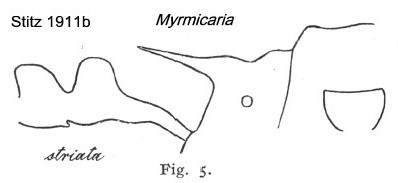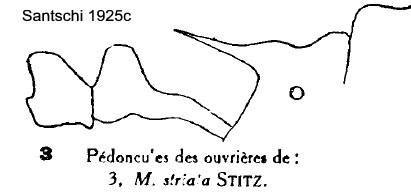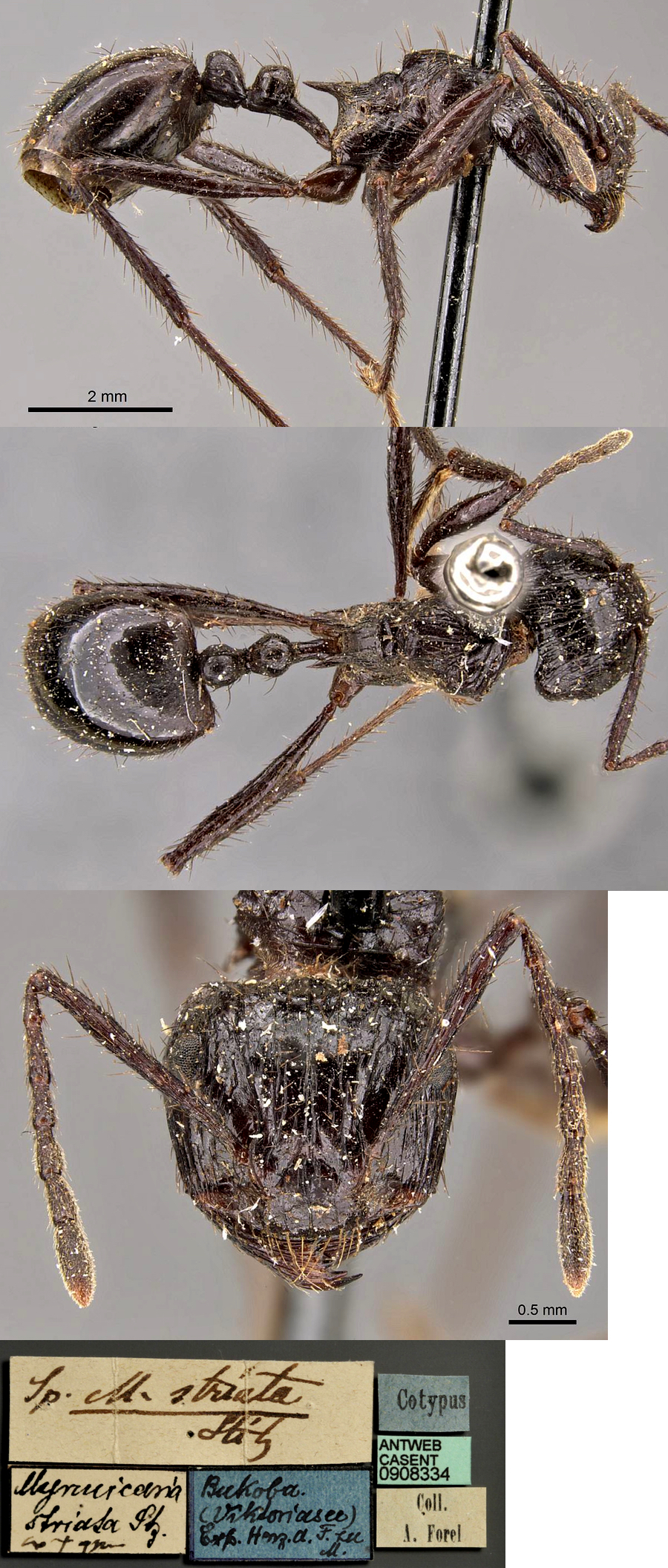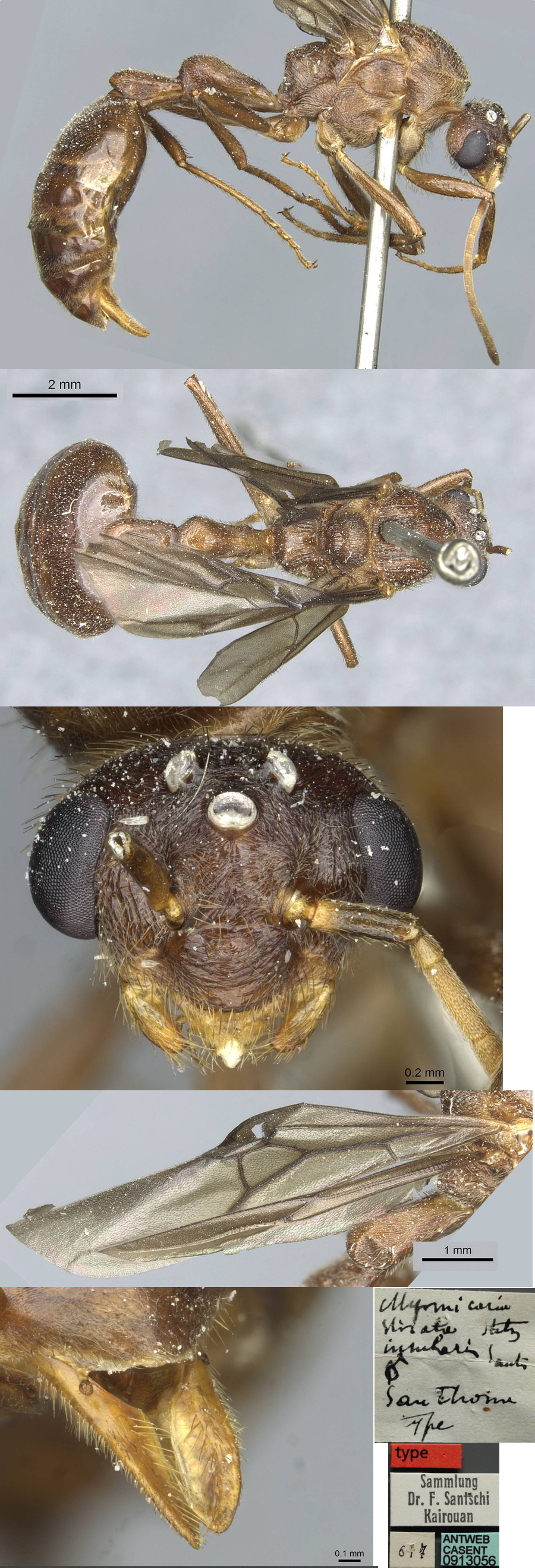Myrmicaria striata Stitz
  Type location Tanzania
(Myrmicaria striata n. sp.,
Stitz, 1911b: 382, illustrated, worker) from Bukoba, Kagera Region,
collector Schubotz - see below Type location Tanzania
(Myrmicaria striata n. sp.,
Stitz, 1911b: 382, illustrated, worker) from Bukoba, Kagera Region,
collector Schubotz - see below
junior synyonyms (here)
buttgenbachi (Myrmicaria
striata Stitz r. Buttgenbachi
n. stirps, Forel, 1913b: 337, worker) from Zaïre - see http://www.antweb.org/specimenImages.do?code=rmcaent000017757
insularis (Santschi, 1920i:
2, worker & male) from Sao Thomé I. - no worker images on
Antweb (October 2014) - male see http://www.antweb.org/specimenImages.do?code=casent0913056
all forms known (see Bolton, 1995)  . .
I have removed the much smaller Myrmicaria pilosa with its
junior synonym angustithorax
to separate species status
|
 Stitz's
(1911b) description is at Stitz's
(1911b) description is at  Forel's (1913b)
description of buttgenbachi
is at Forel's (1913b)
description of buttgenbachi
is at  Arnold (1916: 267) gave
an illustrated translation of striata, this is at Arnold (1916: 267) gave
an illustrated translation of striata, this is at  . Santschi's (1925c) descriptions
are at . Santschi's (1925c) descriptions
are at  and and 
|
 Santschi's
(1925c) description is as follows: Santschi's
(1925c) description is as follows:
WORKER - TL 6.8-8.5. Dark brown intensifying to
black on the head and dorsal alitrunk. Shiny. Central area of face
feebly sculptured as in natalensis and dorsally with parallel
spaced rugae, these are elongated and diverge feebly towards the
vertex. Transverse ridge very faint but always distinct. Antennal
fosses (condylar bulbs?) and antennal area smooth (these have fine
arched rugae in most other species). Sides of head finely
longitudinally rugose with a few oblique anastomoses and a large smooth
area towards the inferior (ventral) border. Pronotal rugae similar to natalensis
with the median carina often much stronger than the laterals, which
arch anteriorly. Scapes and tibiae striate. Lateral alitrunk and
abdomen smooth and shiny. Erect pilosity red-brown, somewhat shorter
and less abundant (this may mean finer) than natalensis.
Head as long as wide in minor workers, a little wider posteriorly in
majors, occipital border as concave as natalensis. Frontal
carinae sinuous; clypeus well defined and striated. Clypeus slightly
convex with a strong median ridge taking the place of a carina and
several lateral striations. Antennae as in natalensis.
Promesonotum dorsum a little more convex than natalensis, with
the dorsal suture impressed and the mesokatepisternal tooth no bigger.
Mesonotal lobes less well developed, not appearing as a flange in
profile. Metanotal groove well developed and more open. Propodeum
dorsum on a raised level as in natalensis but with the borders
not as raised, the dorsum twice as long as wide, indented medially and
less raised anteriorly. Propodeal spines as in natalensis but,
seen in profile, their base seems slightly convex in majors. Pedicel a
good third longer than the node. That has the profile of a truncated
cone with a rounded summit; being a quarter higher than the basal
length. Postpetiole as high as the petiole with the anterior face very
oblique, so as to put the anterior-superior angle about the mid-length
of the node; the posterior face is vertical or even slightly sloping
forward basally.
|
Subspecies buttgenbachi Forel
WORKER - TL 7.5-8 mm. Black, tarsi, mandibles and
clypeus brown-rust. Pilosity brown-black. More striate and less rugose
than type; very shiny, smoother between rugae. Mesokatepisternal teeth
much stronger, and as long as the height of the pronotum, above all
directed laterally and forward. Pedicel nodes shorter, more raised and
more conical, the petiole much wider than long. "Probably from Katanga
Region".
|
Subspecies insularis Santschi
WORKER - TL 6.5-7 mm. Black-brown; dorsum of
head and gaster near black. Mandibles, cheeks, pedicel of petiole,
appendages and anus brown to rust. Erect pilosity yellow, fine shorter
and less abundant than natalensis.
Shiny. Rugae on head longitudinal, irregular, interrupted, spaced, low
and with anastomoses. Alitrunk rugae altogether less strong than on
head, especially the median carina. Both propodeal dorsum and
declivity, the pedicel nodes and the gaster smooth and shiny with
spaced puncturations. Head as in type but a little straighter; clypeus
striated and mandibles with 4 teeth. Mesonotum with an angular dorsal
profile, dorsum sloping downwards slightly to the declivity. Propodeal
dorsum feebly convex and elongated, less raised than baumi and
striata. Propodeal spines horizontal, slightly divergent and a
little less shorter than the declivity. Petiole node as in the type but
the anterior face is more inclined to the in front of the top and more
oblique to the rear. Postpetiole as long as high (height greater in the
type). Summit short and inclined forward. Gaster truncate anteriorly.
Apparently solely from São Tomé.
MALE - taken in isolation; TL 11 mm; black; mandibles,
scape and base of funiculus red; rest of appendages reddish-brown;
wings blackish; pilosity very short, truncated; dorsum of alitrunk
shinier, the interridges smoother than M. eumenoides; propodeum more
angular; node of petiole less clearly delimited, superior anterior face
rising smoothly from the base to the pedicel.
|
 The photomontage of the type worker is collated from http://www.antweb.org/specimen.do?name=casent0908334. The photomontage of the type worker is collated from http://www.antweb.org/specimen.do?name=casent0908334.
|
 The
photomontage of the insularis
male is collated from http://www.antweb.org/specimen.do?name=casent0913056. The
photomontage of the insularis
male is collated from http://www.antweb.org/specimen.do?name=casent0913056.
|
|